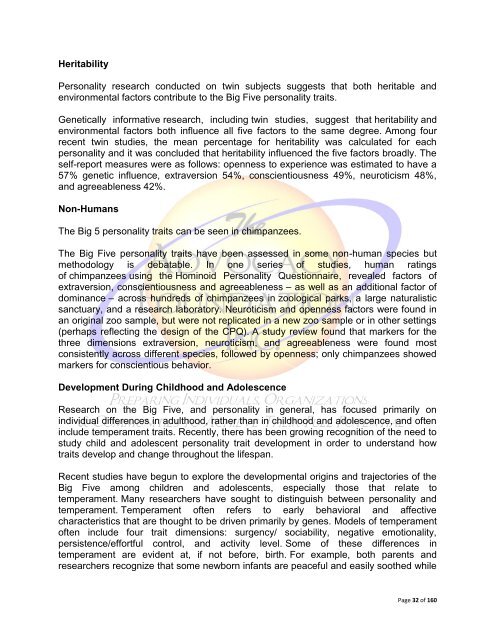The Gift of Introversion
The Gift of Introversion
The Gift of Introversion
Create successful ePaper yourself
Turn your PDF publications into a flip-book with our unique Google optimized e-Paper software.
Heritability<br />
Personality research conducted on twin subjects suggests that both heritable and<br />
environmental factors contribute to the Big Five personality traits.<br />
Genetically informative research, including twin studies, suggest that heritability and<br />
environmental factors both influence all five factors to the same degree. Among four<br />
recent twin studies, the mean percentage for heritability was calculated for each<br />
personality and it was concluded that heritability influenced the five factors broadly. <strong>The</strong><br />
self-report measures were as follows: openness to experience was estimated to have a<br />
57% genetic influence, extraversion 54%, conscientiousness 49%, neuroticism 48%,<br />
and agreeableness 42%.<br />
Non-Humans<br />
<strong>The</strong> Big 5 personality traits can be seen in chimpanzees.<br />
<strong>The</strong> Big Five personality traits have been assessed in some non-human species but<br />
methodology is debatable. In one series <strong>of</strong> studies, human ratings<br />
<strong>of</strong> chimpanzees using the Hominoid Personality Questionnaire, revealed factors <strong>of</strong><br />
extraversion, conscientiousness and agreeableness – as well as an additional factor <strong>of</strong><br />
dominance – across hundreds <strong>of</strong> chimpanzees in zoological parks, a large naturalistic<br />
sanctuary, and a research laboratory. Neuroticism and openness factors were found in<br />
an original zoo sample, but were not replicated in a new zoo sample or in other settings<br />
(perhaps reflecting the design <strong>of</strong> the CPQ). A study review found that markers for the<br />
three dimensions extraversion, neuroticism, and agreeableness were found most<br />
consistently across different species, followed by openness; only chimpanzees showed<br />
markers for conscientious behavior.<br />
Development During Childhood and Adolescence<br />
Research on the Big Five, and personality in general, has focused primarily on<br />
individual differences in adulthood, rather than in childhood and adolescence, and <strong>of</strong>ten<br />
include temperament traits. Recently, there has been growing recognition <strong>of</strong> the need to<br />
study child and adolescent personality trait development in order to understand how<br />
traits develop and change throughout the lifespan.<br />
Recent studies have begun to explore the developmental origins and trajectories <strong>of</strong> the<br />
Big Five among children and adolescents, especially those that relate to<br />
temperament. Many researchers have sought to distinguish between personality and<br />
temperament. Temperament <strong>of</strong>ten refers to early behavioral and affective<br />
characteristics that are thought to be driven primarily by genes. Models <strong>of</strong> temperament<br />
<strong>of</strong>ten include four trait dimensions: surgency/ sociability, negative emotionality,<br />
persistence/effortful control, and activity level. Some <strong>of</strong> these differences in<br />
temperament are evident at, if not before, birth. For example, both parents and<br />
researchers recognize that some newborn infants are peaceful and easily soothed while<br />
Page 32 <strong>of</strong> 160

















